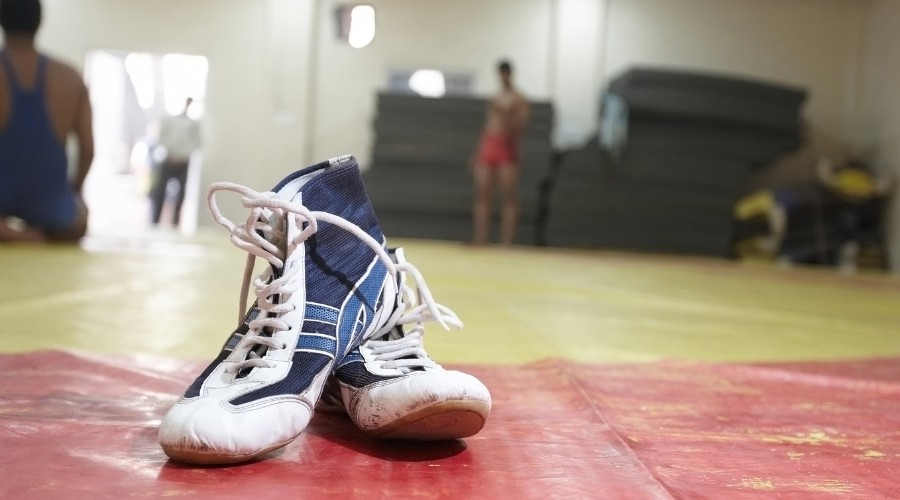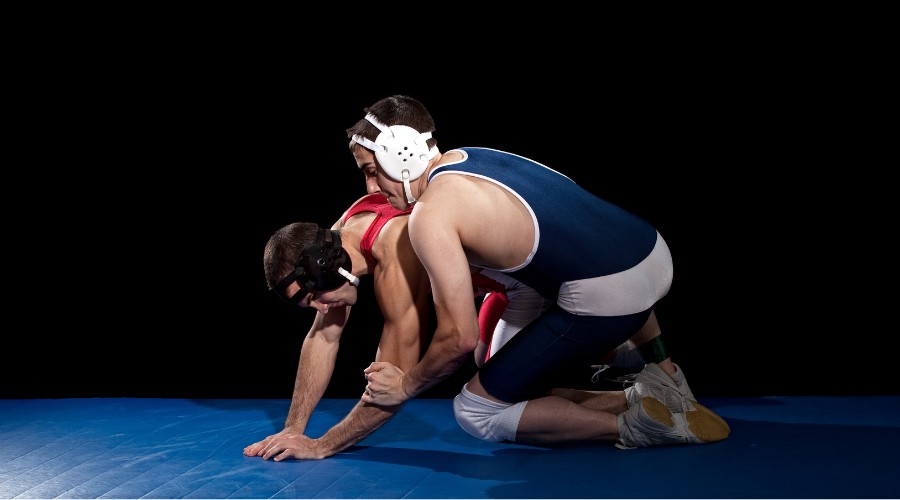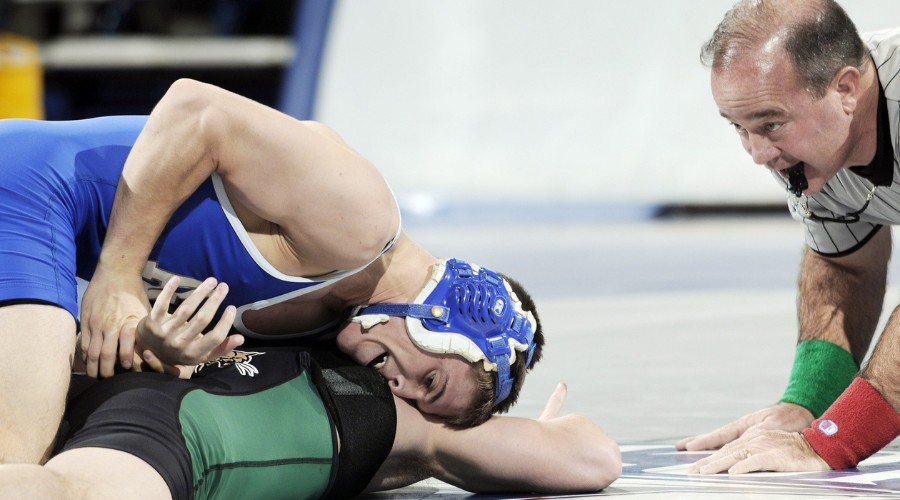The uniform of a sport is often enough for it to be recognized instantly. This is true for all sports, but few competition attires are as symbolic as the one used in wrestling. I am sure you know how wrestlers look, but do you know everything they wear in competition and training?
The wrestling uniform is called a singlet, a single piece of tight-fitting, sleeveless attire made from spandex, lycra, and/or polyester. The wrestling shoes are the second-most important part of the uniform. For training, you can choose from any suitable athletic clothing, like rash guards, t-shirts, shorts, spats, and even shorts and pants.
If you wonder what wrestlers wear underneath their singlets and if they are allowed to use groin cups, you will find the answers inside the article, in addition to more details about the singlet, wrestling shoes, and other types of gear you can use in wrestling.
What Do Wrestlers Wear
Wrestling equipment in competition can vary slightly. Federations, especially international ones, have strict rules about what competitors can wear down to the last minor detail. Naturally, rules for the training room are a lot more liberal, and you can generally choose whatever is comfortable and does not get in the way during wrestling.
Let’s first start with the official competition uniform for wrestling.
Singlet
The singlet is a single-piece, tight-fitting uniform that is the most recognizable symbol of wrestling. The minimalistic attire is designed to allow a full range of motion, avoid getting caught while wrestling, and keep everything in place. The singlet is the closest thing to wrestling naked without actually being naked.
The fabric can vary, but it’s always synthetic, stretchy, and moisture-wicking, like lycra, spandex, and polyester. The exact details of the design vary depending on the federation and tournament, but the differences are minimal.
The commonalities are that a singlet must be tight-fitting, have no zippers, pockets, or loose material, cover the entire torso, and be cut high on the thigh.
The visuals also depend heavily on where they are used. Olympic team singlets have strict requirements on the length of necklines, arm cuts, and length of inseams.
There are also requirements for what prints must be present, like the name and country of the wrestler and what isn’t allowed. In American collegiate wrestling, the singlet also has a team logo and name, as well as the name of the individual competitor.
The singlet has been a part of wrestling since the 1912 Stockholm Olympic Games, and the style is similar to the one used today. In American folkstyle wrestling, singlets were made mandatory in the 1960s.
The length of the cuts and inseams has changed through the years and was more like shorts with suspenders in the 1980s, but the overall design has remained the same, with more or less coverage.
Shoes

Wrestling matches and training are always done with wrestling shoes. They are light and flexible and aim to mimic a barefoot feeling but with more support and traction.
The soles are designed to provide excellent traction in all directions since wrestlers constantly push, cut, and grip the mat with their feet.
All wrestling shoes have a high top, providing adequate ankle support. The shoes also aid in preventing skin infections and open nail scrapes.
Headgear
Wearing headgear is forbidden in international freestyle and Greco-Roman wrestling competitions, but the same rule doesn’t apply to collegiate wrestling. Many folkstyle competitors prefer to wear special wrestling headgear to prevent cauliflower ears.
In the training room, headgear is more common in all styles and is an excellent and proven method to not get your ears mangled unless you want to wear them as a badge of honor.
Knee and Elbow Sleeves
Only light knee sleeves are allowed during competition; again, there are specific rules on what type and length they can be. No wrist and ankle attributes can be worn unless specifically prescribed by a doctor.
Two Piece Uniforms
While international wrestling still only allows singlets in competition, American folkstyle wrestling introduced a two-piece uniform for high school wrestlers in 2017, and the new attire has become increasingly popular since its debut.
The uniform is basically what no-gi BJJ grapplers wear: a tight-fitting t-shirt and MMA-style board shorts. While this attire has a much higher chance of getting in the way during wrestling and restricts movement more than the singlet, some people, especially youths just starting wrestling, prefer it because it is not as exposing.
Compression Shirts
Another option next to a two-piece uniform for high school wrestlers is to wear a tight compression shirt under the singlet. The lower body is still only covered by the singlet, but the upper body gets extra protection and compression thanks to an additional layer of clothing.
What Do Wrestlers Wear Under Their Singlet

A common question people wonder about is what wrestlers wear under their singlets. This may seem strange at first because the singlet does not leave many things hidden, but you can choose a few different options.
Nothing
The singlet aims to produce the feeling and zero obstructions of wrestling naked without being naked, and some wrestlers choose to follow this by wearing nothing underneath their uniform.
Boxer Briefs
The most common choice for wrestlers is to wear normal boxer briefs. The benefits are obvious- it’s more hygienic, more concealing, keeps the genitals in place, and everyone already wears underwear anyway, so you don’t need to buy anything. But there is a superior option for wrestling, and it’s compression shorts.
Compression Underwear
A trendy option amongst wrestlers is compression underwear. It provides both muscle support and coverage for the genitals.
Good compression shorts support blood flow, provide support and stability for the muscles, absorb sweat, and often have antibacterial properties similar to rash guards.
Jockstrap/Cup
Others go a more minimalistic way and wear just a jockstrap under the singlet, but this is more of an old-school thing, and most wrestlers today use either tight boxer shorts or compression shorts.
Hard protective cups inside the jockstrap are not allowed under most wrestling rulesets because they can be used to accidentally or intentionally hurt the opponent.
Still, some federations and tournaments may allow some groin protection, but consult your coaches and the officials about this matter if you don’t want to get disqualified.
Sport Bra
Female wrestlers can and usually do choose to wear a sports bra underneath the singlet. Sports bra hold their breasts in place and can even help against mat burn or embarrassing exposure in case of singlet “malfunctions.”
What To Wear For Wrestling Practice

Unlike in competitions, you have much more wardrobe options in the wrestling room. Some people choose to train in singlets, but this is rare, and other types of clothing are much more common.
Most wrestlers train with rash guards, regular t-shirts, tank tops, or even topless. Fight shorts are worn underneath, or any other kind of shorts without pockets and exposed metal or plastic parts. Even jogging pants and sweatshirts are frequent in wrestling rooms for those needing to cut weight.
You can also wear a lot more supportive and protective gear while training. Knee braces are common and offer a welcome relief for joints, ligaments, and skin. If you want to avoid having cauliflower ears, the best option is to use quality wrestling headgear.
Summary
The wrestling singlet is a practical uniform that stays out of the way and does not restrict movement. In folkstyle wrestling, two-piece uniforms similar to those used in no-gi grappling were introduced a few years ago, and they are also a popular choice for the training room.
Under the singlet, you can wear briefs, compression shorts, a jockstrap, or even no underwear. Wrestling shoes are another key element of the wrestling uniform, providing much-needed traction and ankle stability. If you intend to compete in wrestling, the coaches will tell you exactly what uniform you need, but for training, you can go for any athletic gear and be fine.
